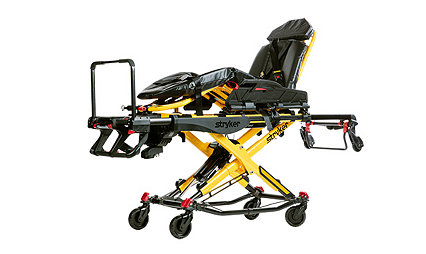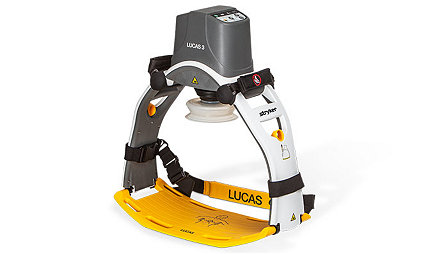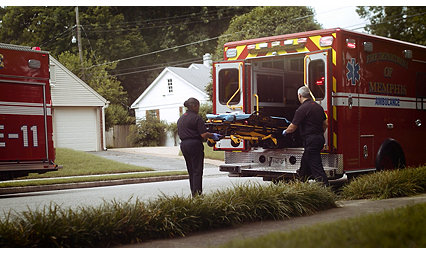You don't quit, and your gear can't either
Support your crew with powered solutions ready for every call
Every call is different, but your gear should be a constant. A standardized fleet of powered equipment helps bring consistency and reliability to every call. Stryker’s connected ecosystem—LIFENET System, LIFEPAK 35, Power-PRO 2, Power-LOAD, Xpedition, the LUCAS device—works together to help you move efficiently and respond with confidence. Because in the high-stakes world of EMS, reliability isn’t a luxury. It’s a necessity.
Power your response
With one connected ecosystem
When a patient is critical, every second counts. Making treatment and care decisions from multiple data sources can waste precious time, create extra work and challenge performance goals.
With our connected, powered ecosystem, EMS and hospital have access to near real-time data for informed team alignment and coordination of care.* Devices like the LIFEPAK 35 and LUCAS are built with data solutions that provide actionable insights into areas of team performance including CPR quality, operational efficiency, and post-event analysis. Power-PRO 2, Power-LOAD and Xpedition help streamline patient handling and gear transports, helping to support a more efficient response. Meanwhile, the LIFENET System connects care teams, allowing hospital clinicians to view incoming patient details and preparing them for the patient's arrival. This exchange enables EMS to adjust care mid-transport while hospitals prep resources. The result? Confident decision-making and coordinated care for EMS crews and hospital care teams.
*The LUCAS device does not provide patient data or real time information.

The LIFENET System is a comprehensive cloud-based platform that intelligently manages and delivers patient information and device data that EMS and hospital teams need to work together seamlessly.
Lift, lower and transport with confidence. Power-PRO 2 is the industry's first connected ambulance cot, built for the relentless workload of EMS.
Lift smarter, not harder. Power-LOAD supports the weight of the cot and patient, securing your cot and supporting your team.
Rugged, reliable and ready for every call—LIFEPAK 35 delivers advanced monitoring and lifesaving defibrillation in an intuitive, ruggedly-designed1 device built for the field.
Consistent compressions. Less fatigue. The LUCAS device delivers high-quality chest compressions, so your team can stay focused on other life-saving tasks.
Tight spaces. Steep stairs. Unpredictable terrain. Xpedition powers through—getting patients where they need to go.
Products
Solutions for out-of-hospital medical emergencies
Featured articles
EMS powered products
In the unpredictable world of emergency response, every minute counts. Split-second decisions and unwavering courage are the norm. These are the firefighters, EMS professionals, nurses and rescuers who confront chaos with unwavering determination every single day. At Stryker, we stand shoulder to shoulder with these brave individuals, committed to being their ally in the fight to save lives and deliver quality care. But their work is not for the faint of heart.
Learn moreHow the right equipment can help recruit and retain EMTs and paramedics
Reduce the risk of caregiver injury when loading and unloading cots.
Learn moreKnowing when to use an AED: CPR and AED guidelines for sudden cardiac arrest
When to use an AED is crucial in sudden cardiac arrest situations. Learn how to recognize sudden cardiac arrest symptoms and act promptly to help increase the chance of survival.
Learn moreEMS Stories: Provo Fire and Rescue
We spoke with Provo Fire & Rescue, in Provo, Utah. Hear about the care they administer in the back of their ambulance on a day-to-day basis.
Learn moreInterested in learning more? Connect with an expert.
Have feedback about Stryker’s products and services? Visit our product experience page to connect with us.
ProCare Services
Our expert medical device technicians help ensure your equipment is ready to perform when you need it. With preventive maintenance plans and tailored service support, we help you maximize the life of your equipment—and your investment.
Shop accessories and disposables
Help keep your staff and patients safe. Our accessories and disposables have been thoroughly tested with our products and you can shop for them here:

Power to purchase
Through our Flex Financial business we can help you acquire our full portfolio of products and offer numerous payment structures that can be customized to meet your budgetary needs.
1. Data on file, Stryker SHVR 3338410.
2. Armstrong, D. P., Ferron, R., Taylor, C., McLeod, B., Fletcher, S., MacPhee, R. S. & Fischer, S. L. (2017). Implementing powered stretcher and load systems was a cost effective intervention to reduce the incidence rates of stretcher related injuries in a paramedic service. Applied Ergonomics, 62, 34–42. https://doi.org/10.1016/j.apergo.2017.02.00
3. Fredericks, T. K., Butt, S. E., Harms, K. S. & Burns, J. D. (2013). Evaluation of Medical Cot Design Considering the Biomechanical Impact on Emergency Response Personnel. The XXVth Annual Occupational Ergonomics and Safety Conference.
4. Lad, U., Oomen, N. M. C. W., Callaghan, J. P. & Fischer, S. L. (2018). Comparing the biomechanical and psychophysical demands imposed on paramedics when using manual and powered stretchers. Applied Ergonomics, 70, 167–174. https://doi.org/10.1016/j.apergo.2018.03.001
5. McGill, S. M. (1997). The biomechanics of low back injury: implications on current practice in industry and the clinic. Journal of Biomechanics, 5, 465–475. 6Studnek, J. R., Crawford, J. M. & Fernandez, A. R. (2012). Evaluation of occupational injuries in an urban emergency medical services system before and after implementation of electrically powered stretchers. Applied Ergonomics, 43(1), 198–202. https://doi.org/10.1016/j.apergo.2011.05.001
6. Stryker,OI, 3350840
7. Stryker HFVR 3338373
8. Stryker SHVR 3338410
9. Sporer K, Jacobs M, Derevin L, et al. Continuous quality improvement efforts increase survival with favorable neurologic outcome after out-of-hospital cardiac arrest. Prehosp Emerg Care. 2017;21(1):1-6
10. Internal Data on File. LCCRD, 3349947.
11. Internal Data on File. LCCRD, 3347969.
EC-GSNPS-SYK-1079710_REV-1_en_us






















